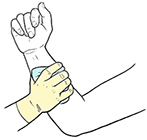First Aid: Cuts and Scrapes
First Aid: Cuts and Scrapes
A break in the skin is an open door, inviting dirt and germs to enter your body and cause infection.
Step 1. Control bleeding
Apply direct pressure for at least 5 minutes.
Step 2. Clean and cover
Wash the scrape or cut with soap and water to kill germs and remove dirt and foreign objects.
Apply a topical antibiotic to minor cuts and scrapes that do not need medical attention (see below).
Cover the wound with a clean gauze dressing to reduce the risk of infection and further injury. Keep the dressing in place with a gauze or cloth bandage.
Don't tie or tape the bandage too tight.
When to call the healthcare provider
Call the healthcare provider right away if any of the following is true:
The wound covers a large area or is deep.
The injury is on the face or any other area where scarring is a concern.
The person needs protection against tetanus. This is a disease caused by bacteria that may enter any break in the skin and bring on a life-threatening illness called lockjaw. A tetanus booster (injection) may be needed if it's been more than 5 years since the last tetanus vaccine.
Call 911
Call 911 if the victim has any of the following
Uncontrollable bleeding
Shock symptoms:
The skin is pale or clammy
The pulse is so light or races so fast that you can't count the beats.
The victim is confused or unable to concentrate, or stares blankly. Over time, the victim may even become unconscious.
A detached body part: Keep all fragments of the detached part dry. Put them in a plastic bag or other container first, and then put bag or container in ice or cold water to improve chances for reattachment. Send the parts to the hospital along with the victim.
While you wait for help
Reassure the person.
Continue to control bleeding with direct pressure.
Updated:
October 09, 2017
Sources:
Part 17: First Aid: 2010 American Heart Association and American Red Cross Guidelines for First Aid. Markenson, D. Circulation. 2010;122(18):s934-6.
Reviewed By:
Image reviewed by StayWell medical illustration team.,Moloney, Amanda Jane (Johns), PA-C, MPAS, BBA,Perez, Eric, MD

